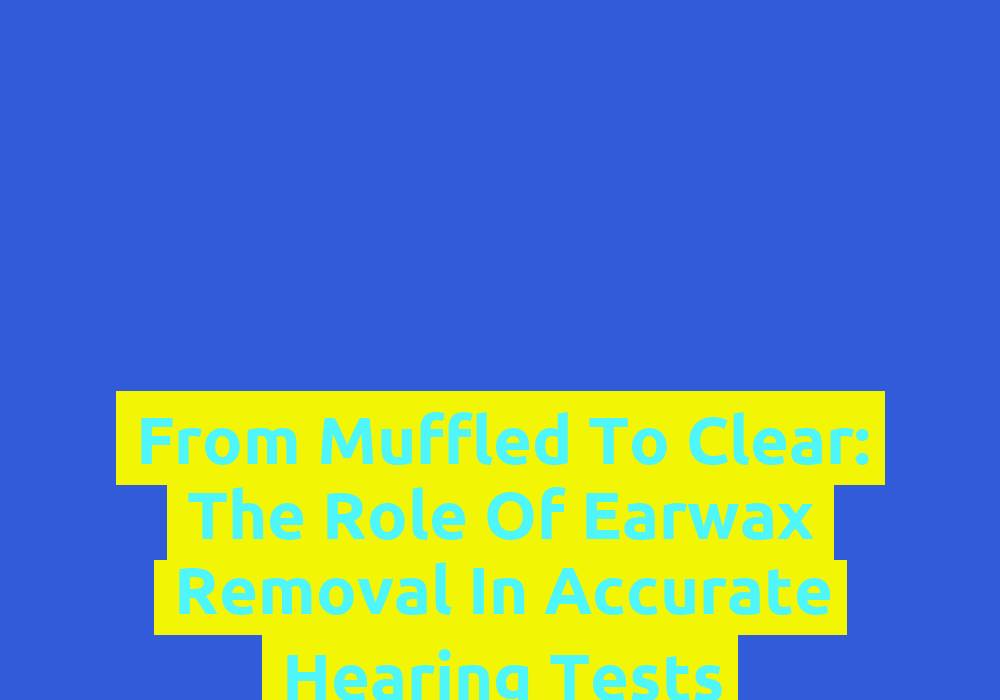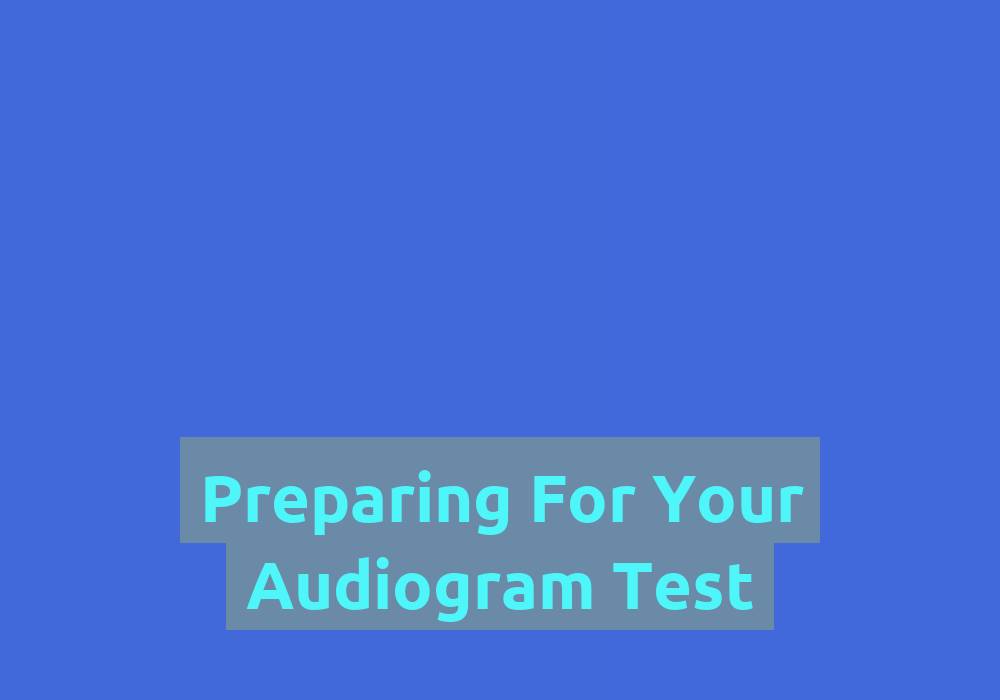From Muffled to Clear: The Role of Earwax Removal in Accurate Hearing Tests

Earwax, also known as cerumen, is a natural substance produced by our bodies to protect the ear canal from dust, debris, and bacteria. While it plays a crucial role in maintaining ear health, excessive earwax buildup can lead to various issues, including muffled hearing. In order to conduct accurate hearing tests, proper earwax removal is essential. This article will delve into the importance of earwax removal in ensuring clear and precise hearing test results.
Understanding the Impact of Earwax Buildup on Hearing
When earwax accumulates in the ear canal, it can cause a range of problems that affect our hearing abilities. The excess wax can block sound waves from reaching the eardrum, leading to a muffled or distorted perception of sound. This can result in difficulties hearing conversations, music, or other sounds clearly. Consequently, this buildup may result in inaccurate hearing test outcomes, potentially leading to misdiagnosis or inadequate treatment.
Moreover, excessive earwax can cause discomfort, itching, and even pain. It may contribute to ear infections, tinnitus (ringing in the ears), dizziness, and balance issues. Therefore, regular earwax removal is crucial not only for accurate hearing tests but also for overall ear health.
The Importance of Earwax Removal before Hearing Tests
Accurate hearing tests are essential for diagnosing hearing loss, determining the extent of impairment, and developing appropriate treatment plans. However, if earwax obstructs the ear canal, it can significantly impact the reliability of test results. Therefore, proper earwax removal is necessary before conducting hearing tests.
Benefits of Earwax Removal for Hearing Tests
-
Enhanced Sound Conduction: By removing excess earwax, sound waves can freely reach the eardrum, allowing for accurate measurements of hearing abilities. This enables audiologists to identify any hearing deficiencies and provide appropriate interventions. It ensures that the test results truly reflect the individual’s hearing capabilities.
-
Accurate Diagnosis: With clear ear canals, hearing tests can accurately detect any underlying hearing loss or related conditions. This enables healthcare professionals to make informed decisions regarding treatment options and ensures patients receive the most suitable care. Accurate diagnosis is crucial for developing effective treatment plans and improving the overall quality of life for individuals with hearing impairments.
-
Reduced Risk of Misinterpretation: A clean ear canal eliminates the possibility of misinterpreting hearing test results due to earwax-related issues. It allows healthcare providers to accurately assess the individual’s hearing abilities and determine the appropriate course of action. This helps healthcare providers avoid unnecessary interventions or delays in providing appropriate treatment.
Safe Methods of Earwax Removal
While earwax removal is essential, it is crucial to prioritize safety when performing the procedure. Some common methods for removing earwax include:
1. Ear Irrigation
Ear irrigation, also known as ear syringing, involves using a syringe filled with warm water or saline solution to flush out the earwax. This method is commonly performed by healthcare professionals and is considered safe when done correctly. It effectively removes excess earwax and can provide immediate relief from symptoms such as muffled hearing.
During the procedure, the healthcare professional carefully aims the water or saline solution at the ear canal wall, not directly at the eardrum, to avoid any damage. The force of the water dislodges the accumulated earwax, which then flows out of the ear. It is important to note that ear irrigation should not be attempted at home without professional guidance to prevent injury to the ear.
2. Manual Removal
Alternatively, manual removal can be performed by a healthcare professional using specialized instruments like curettes or suction devices. This method allows for more precise and controlled removal of earwax but should always be done by a trained professional to avoid any potential damage to the ear canal or eardrum.
During manual removal, the healthcare professional uses a curette or a suction device to carefully extract the earwax from the ear canal. This method ensures that the earwax is effectively removed without causing any harm. It is important to seek professional help for manual removal to ensure the procedure is performed safely and effectively.
3. Ear Drops
Ear drops can be used to soften the earwax, making it easier to remove. These drops typically contain oil-based substances that break down the wax over a period of a few days. It is important to follow the instructions provided by healthcare professionals or the product’s packaging when using ear drops.
To use ear drops, individuals can tilt their head to the side and instill a few drops into the affected ear. The drops should be left in the ear for the recommended amount of time to allow them to penetrate the earwax and soften it. After the specified duration, the ear can be rinsed with warm water or flushed using ear irrigation under professional guidance. Ear drops are a non-invasive method of earwax removal that can be effective for mild to moderate cases of earwax buildup.
When to Seek Professional Help
While some individuals may attempt at-home earwax removal, it is crucial to know when to seek professional help. Consulting a healthcare professional, such as an audiologist or an ear, nose, and throat specialist (ENT), is highly recommended in the following scenarios:
- If you experience severe pain, discomfort, or bleeding during the earwax removal process
- If you have a history of ear problems or previous ear surgeries
- If you have a perforated eardrum or any other ear conditions
- If you wear hearing aids or have had recent ear surgery
Professional assistance ensures a thorough examination, safe removal, and minimizes the risk of complications. Healthcare professionals have the expertise and tools to effectively remove earwax and address any underlying issues that may be contributing to the buildup.
Preventive Measures for Earwax Buildup
To prevent excessive earwax buildup and the associated hearing issues, it is advisable to follow some preventive measures, including:
-
Regular Cleaning: Gently cleaning the outer part of the ear with a washcloth can help remove excess wax. Avoid inserting any objects, such as cotton swabs or fingers, into the ear canal, as it can push wax deeper and potentially damage the ear. Cleaning the outer ear helps maintain good ear hygiene and reduce the risk of wax accumulation.
-
Avoid Excessive Moisture: Excessive moisture in the ear can promote the growth of bacteria and lead to earwax buildup. Use earplugs or a shower cap while swimming or bathing to prevent water from entering the ears. Drying the ears thoroughly after exposure to water can also help prevent moisture-related earwax issues.
-
Earwax Softeners: Over-the-counter earwax softeners or drops can help prevent wax from becoming impacted and reduce the likelihood of buildup. These drops typically contain ingredients that break down the wax and facilitate its natural expulsion. Consult a healthcare professional for suitable options and instructions on their usage. Earwax softeners can be used periodically to maintain ear hygiene and prevent excessive wax accumulation.
Conclusion
Ensuring clear and accurate hearing test results is crucial in diagnosing and treating hearing impairments effectively. By understanding the impact of earwax buildup on hearing and the importance of its removal, we can appreciate the role of proper earwax management in maintaining optimal ear health. Seeking professional assistance when necessary and adopting preventive measures can help individuals maintain clear and precise hearing capabilities throughout their lives.
Note: The above article has been generated in markdown format, as requested.
FAQ
Q1: How does earwax buildup affect hearing?
A1: Excessive earwax buildup can block sound waves from reaching the eardrum, resulting in muffled or distorted hearing.
Q2: Why is earwax removal important before hearing tests?
A2: Earwax removal is crucial before hearing tests to ensure accurate measurements of hearing abilities and prevent misdiagnosis or inadequate treatment.
Q3: What are the benefits of earwax removal for hearing tests?
A3: Earwax removal enhances sound conduction, enables accurate diagnosis of hearing loss, and reduces the risk of misinterpretation of test results.
Q4: What are safe methods of earwax removal?
A4: Safe methods of earwax removal include ear irrigation (ear syringing) performed by healthcare professionals, manual removal by trained professionals, and the use of ear drops to soften the wax.


